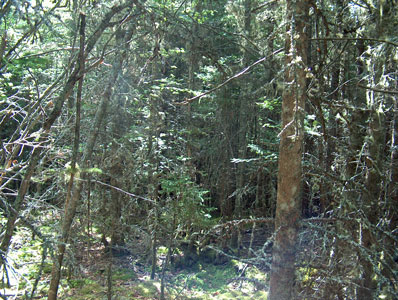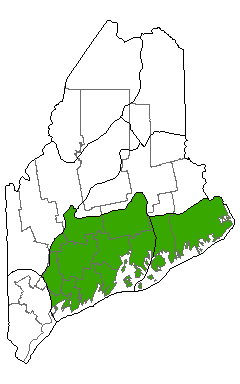DACF Home → Bureaus & Programs → Maine Natural Areas Program → Communities, Plants, and Animals → Natural Community Fact Sheets → Maritime Spruce - Fir Forest
Printer Friendly Fact Sheet - 900 KB pdf (Get a free copy of Adobe Acrobat Reader)
Maritime Spruce - Fir Forest
Scientific Name: Maritime Spruce - Fir Forest; State Rank: S4

- Community Description
- Soil and Site Characteristics
- Diagnostics
- Similar Types
- Conservation, Wildlife and Management Considerations
- Distribution
- Characteristic Plants
- Associated Rare Plants
- Associated Rare Animals
- Examples on Conservation Lands You Can Visit
Community Description: Red spruce, white spruce, balsam fir, and/or larch are dominant in this Downeast coastal type. Composition is variable from the mid-coast to the Downeast coast. Red and white spruce are the most typical dominants; northern white cedar or hemlock are rarely co-dominant. The canopy may contain gaps with regenerating red maple, paper birch, mountain-ash, heart-leaved paper birch, and fir. Herbs and dwarf shrubs are typically <10% cover each, though in the canopy openings species such as raspberries, rough-stemmed goldenrod, whorled aster, and hay-scented fern may be locally abundant. The bryoid layer is >15% cover, dominated by mosses and liverworts rather than lichens. Back to top.
Soil and Site Characteristics: Sites are along the immediate coast, often foggy and cool, on flats or lower to mid slopes (0-15%, may be steeper). Soils are shallow (<40 cm) over bedrock or till, with a well developed organic layer, acidic (pH 4.8-5.2) and mesic. Texture is sandy to loamy. Back to top.
Diagnostics: White spruce, bayberry, hay-scented fern, and mountain cranberry are indicators, though not always present. Sites contain relatively little or no bluebead lily, wood-ferns, or painted trillium. Broom-mosses do not dominate the bryoid layer, though they are often present. Back to top.
Similar Types: Lower-elevation Spruce - Fir Forests are the most similar. They occur in more inland settings and, like this type, often have only sparse herbs, but unlike this type they are dominated by red spruce rather than white spruce and balsam fir, and their bryoid layer is dominated by broom-mosses. In poorly drained areas, Maritime Spruce – Fir Forests may grade into the Spruce - Fir Wet Flat, which is distinguished by seasonally flooded or saturated soils and a more prominent cover of herbs and bryoids; along the coast, it usually occurs in small bedrock basins. Back to top.
Conservation, Wildlife and Management Considerations: After centuries of intensive use, almost no original coastal forest remains. Many now mature forests are on old pastureland. Many good (albeit secondary-growth) sites are in conservation ownership. Acadia National Park contains a variety of successional stages of this type, including stands that burned in 1947 and stands that did not. Maritime forests are subject to higher wind and weather stress than inland sites, and as a result the disturbances tend to be higher intensity and more frequent, and the trees do not grow as old.
This community type may be utilized as nesting habitat by a number of coniferous forest specialist bird species such as the sharp-shinned hawk, yellow-bellied flycatcher, Cape May warbler, blackpoll warbler, bay-breasted warbler, northern parula, boreal chickadee, Swainson's thrush, red crossbill, and white-winged crossbill. Back to top.
Distribution: Coastal, primarily from mid-coast Maine eastward into the Canadian Maritimes (Laurentian Mixed Forest Province). Landscape Pattern: Large Patch. Back to top


Characteristic Plants: These plants are frequently found in this community type. Those with an asterisk are often diagnostic of this community.
- Canopy
- Balsam fir*
- Red spruce*
- White spruce*
- Eastern hemlock
- Mountain ash*
- Northern white cedar
- Paper birch*
- Sapling/shrub
- Balsam fir*
- Red spruce
- White spruce*
- Mountain ash*
- Herb
- Balsam fir
- Bayberry*
- Raspberries
- Mountain cranberry*
- Red spruce
- Rough-stemmed goldenrod
- Hay-scented fern
- Bryoid
- Dicranum moss
- Pincushion moss
- Three-lobed bazzania
There are no documented rare animals associated with this natural community.
Examples on Conservation Lands You Can Visit
| Example | County |
|---|---|
| Black Point Brook, Cutler Public Lands | Washington Co. |
| Great Wass Island Preserve | Washington Co. |
| North Cutler Coast, Cutler Public Lands | Washington Co. |
| West Quoddy Head State Park | Washington Co. |